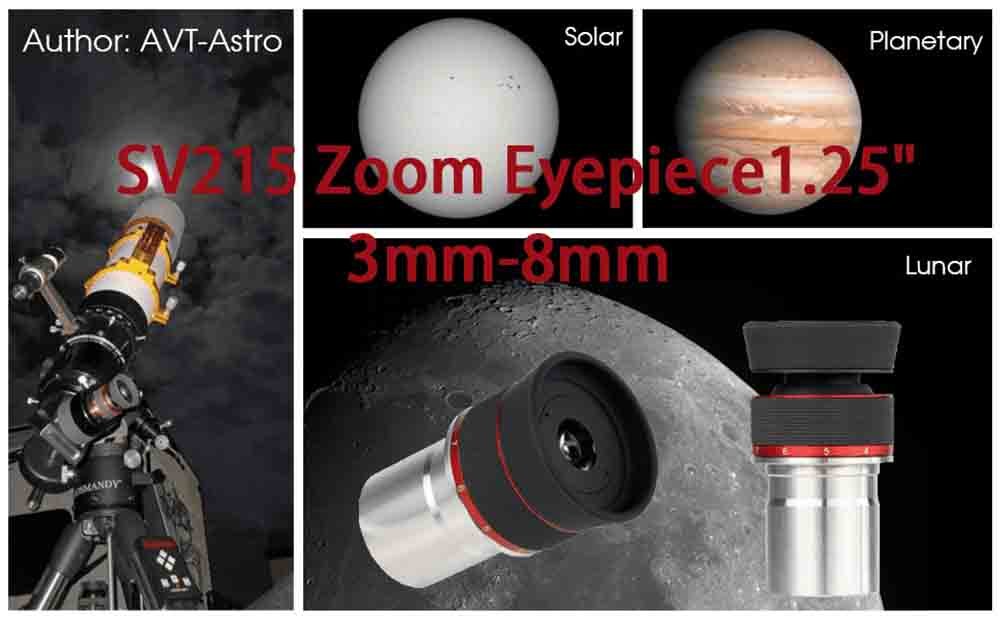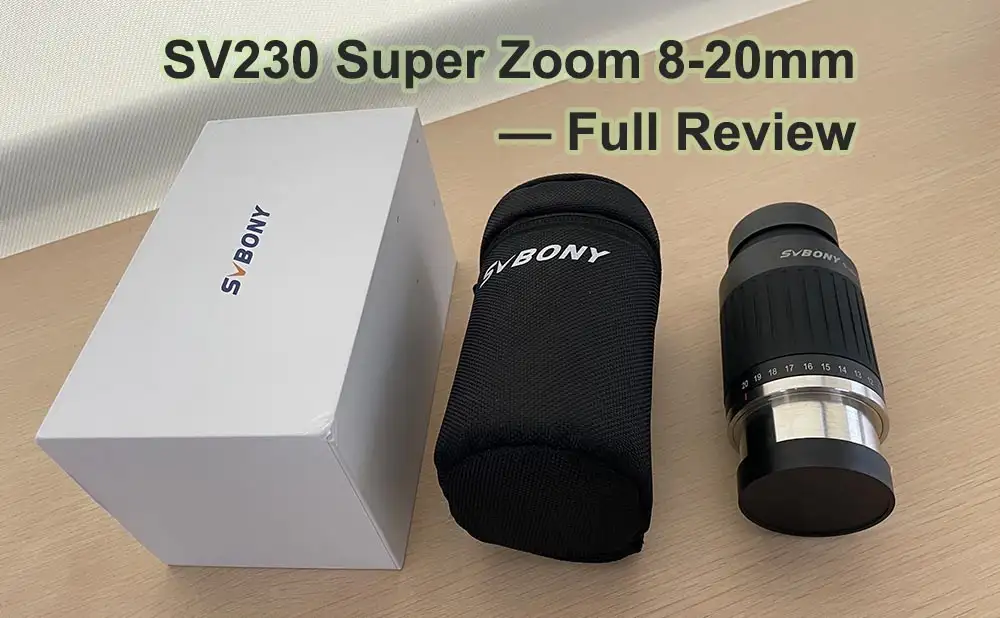Reviews—About SV215 Zoom 1.25" 3mm-8mm Eyepiece

Reviews—About SV215 Zoom 1.25" 3mm-8mm Eyepiece
This is a real and honest product review. Posted by Alan Dyer on AstroGearToday, we noticed it and shared it with you, if you happen to be interested in this zoom eyepiece, you should take a few minutes to browse it.
Price and Quality in a High-Power Zoom: SVBONY 3mm-8mm Zoom Review
Here’s a low-cost zoom eyepiece that actually works well. I was surprised!
I’ve never been a fan of zoom eyepieces. Most suffer from variable fields of view, with their apparent fields often narrowest at their longest focal lengths, just where you want the widest field possible. Low-cost zooms can suffer from flares and ghost images caused by internal reflections from the many lens elements. I’ve considered most zoom eyepieces best reserved for public outreach use.
The only zoom eyepiece I’ve found that works well for critical personal observing is Tele Vue’s 3mm-6mm Nagler Zoom. It sells for about $430 and has a narrow, albeit consistent, 50° apparent field across its zoom range.
An obvious clone of the Nagler Zoom is the new 3mm-8mm “Planetary Zoom” eyepiece, from the Hong Kong company SVBONY. At just $150, their Zoom vastly undercuts the competition. But is it any good? Surprisingly, it is.
(Note: My test unit was not sent on loan; I purchased it from Amazon, SVBONY’s main sales outlet in North America.)
Optical Performance
The SV215 (to use its official model number) offers a larger range of focal lengths than the Nagler Zoom, from 3mm to as long as 8mm, for a 2.7x zoom range. It also provides a slightly wider apparent field of view of 56°.
That’s the advertised figure, but I found it to be accurate. The SV215 provides a noticeably wider apparent field than a standard 50° Plössl, but slightly less than a 60° Tele Vue Radian eyepiece. The field is stated as being constant; I found it actually widens slightly as it zooms to its shortest focal length, reaching about 57° to 58° at 3mm.
Another key specification is eye relief – how far your eye can be from the eyepiece and still see the entire field. For comfortable viewing, I find an eye relief of 15 to 20mm ideal. But high-power, short-focal length eyepieces often have eye relief of just millimeters, making them difficult to look through.
SVBONY states the SV215 offers a constant 10mm of eye relief over its zoom range, the same as the Nagler Zoom. I found this figure to be correct at the long end of the range, but the eye relief shortened a bit to 8mm at the eyepiece’s shortest focal length.
Even so, seeing the entire field was no problem over the entire range, even with the rubber eyecup rolled up. The eyepiece was still quite comfortable to use at all powers, certainly much more so than most short focal length Plössl eyepieces.
Most critically, in testing the eyepiece on the Moon, Venus and bright stars I found its image quality to be very good. With bright objects in the field or just outside the field there were no ghost images or lens flares. Images looked sharp almost to the edge of the field, showing only a little smearing and lateral color close to the well-defined field stop. I saw no false-color fringing (chromatic aberration) introduced by the eyepiece, either on Venus or on the rims of lunar craters or limb of the Moon.
In A-B tests one night with my Astro-Physics Traveler, a 105mm apochromatic refractor known for its color-free optical excellence, I compared the SVBONY Zoom to a Tele Vue Delos 3.5mm, an Astro-Tech 4mm UWA, and a Zeiss Jena 10mm Abbé Orthoscopic, a legendary 4-element eyepiece prized for its high contrast.
SVBONY’s 6-element Zoom held its own very well against the premium and classic competition. I could see no obvious degradation of image brightness, contrast, neutral color, or sharpness in the zoom. Of course, the Delos and UWA provided wider fields of view, of 72° and 82° respectively. And the Delos has a lovely 20mm of eye relief, but it sells for $380.
Despite its more modest field of view, the Zoom still presented impressive views of the Moon, with the convenience of being able to zoom in quickly to specific areas for a closer look.
Mechanical Features
The SV215 Zoom looks attractive and is solidly made. It has a dense, all-metal and glass construction. There’s nothing cheap or plasticky about it.
The top of the eyepiece has a ring that turns to vary the focal length with click stops at each millimeter setting. The red-trimmed ring is covered with a textured grip. Its mechanism is a little stiff, requiring some force to adjust. Once the eyepiece is in place, only the rotating grip ring is exposed. The eyepiece has to be firmly locked into a star diagonal or focuser or the entire eyepiece will turn when you try to zoom it. The grip ring got even stiffer in sub-freezing temperatures. However, the zoom mechanism works well, with very little wobble in the sliding top barrel even at its maximum extension.
The clip-on rubber eyecup is flexible but is held firmly in place; I never found it popping off accidentally. It can be rolled down, if needed; with it down I found it possible to still see the whole field with my glasses on. But I always used the Zoom with its eyecup rolled up, its normal position for the top cap to fit on.
SVBONY advertises the Zoom as being parfocal but warns “minor tweaking may be necessary.” That, too, is accurate. While the Zoom stays close to the same focus point over its zoom range, it is necessary to adjust the focus slightly as you shift the focal length from one extreme to the other.
The lower section of the barrel is 35mm long, a little longer than most 1.25-inch diameter eyepieces. It will not slide all the way into some standard 1.25-inch star diagonals, though it can still be secured in place with no problem.
Who Is It For?
A zoom with a relatively limited focal length range like this one is not a general-purpose eyepiece. The SV215 is rightly advertised as a high-power lunar and planetary eyepiece. I would add double stars to its list of suitable subjects.
However, this is not an eyepiece for use on long-focal-length telescopes such as Schmidt-Cassegrains – the Zoom will provide too much power to be useful over most of its range.
The SVBONY Zoom is ideal for use on high-quality but short-focus refractors, which typically have focal lengths of 400mm to 800mm. On a 100mm f/6 refractor, for example, the Zoom will yield 75x to 200x, a good range of magnifications.
The advantage of a quality zoom is being able to dial in just the right amount of power for the subject and the night’s seeing conditions. SVBONY has provided an excellent and affordable choice for high-power observing. At its low cost, I think their 3mm-8mm Zoom is a worthwhile addition to an observer’s eyepiece case. It’s certainly in mine now.
Plus
Excellent sharpness and contrast
Lack of chromatic aberration and ghosts
Nearly constant 56° field of view
Low cost
Minus
Zoom mechanism a little stiff
Short but adequate eye relief
Longer than usual lower barrel
__________________________________________________________________________________________
You can also check out the entirety of this article on this website.
https://astrogeartoday.com/price-and-quality-in-a-high-power-zoom-svbony-3mm-8mm-zoom-review/
If you have tested it too, welcome to share your thoughts with us!









avenue17
You very talented person